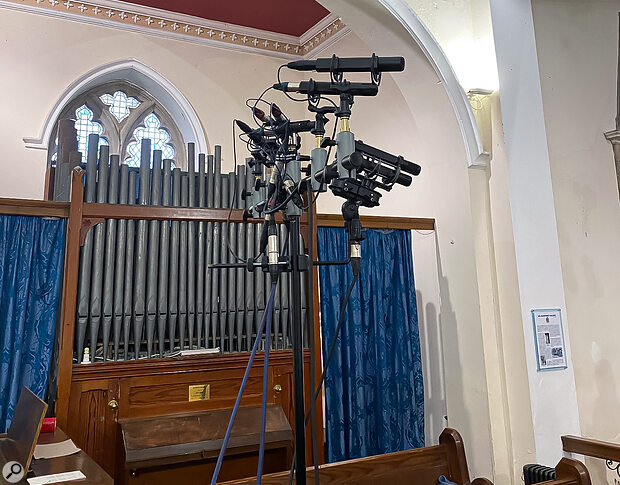 The main array used to capture these files.
The main array used to capture these files.
To illustrate the differences, strengths and weaknesses of different stereo mic arrangements I have made a series of demonstration recordings captured over about an hour on a warm summer’s evening. The choir is the Teme Valley South Churches Choir (TVSCC), founded and conducted by Chloe May Evans. The location is a hilltop church in Herefordshire which is pretty reverberant and although it sounds very pleasant, that reverberation does make it a little harder to hear the stereo imaging differences. Nevertheless, I am immensely gratefully for the enormous generosity and patience of this excellent choir as they performed the same piece — 'If Ye Love Me' by Thomas Tallis — repeatedly in front of a number of different mic arrays, some being reconfigured and/or physically moved between takes.
www.soundonsound.com/techniques/stereo-part-2
The different tracks and their noteworthy characteristics are described in detail in the Stereo Microphone series of articles. But the brief file descriptions below will give pertinent clues! All files are 24-bit / 48kHz with no processing whatsoever other than a little gain adjustment for approximate level matching.
The MP3s below are provided for quick reference but downloading the Zip file of hi-res WAVs will let you audition and compare the techniques in your own DAW.
Coincident Stereo Mic At Distance
1. Neumann SM69 Figure-8s
2. Neumann SM69 Hypercardioids
3. Neumann SM69 Cardioids
Coincident Stereo Mic At Different Distances
4. Figure-8 distant SM69
5. Hypercardioids midway SM69
6. Cardioids closest SM69
Coincident Mid-Sides
7. Sennheiser MKH40/30 (NOT decoded, Mid on Channel 1)
Near Spaced Arrays
8. ORTF (Rode TF5s)
9. Faulkner Cardioids* (Sennheiser MKH40s)
10. Schneider Disc (Sennheiser MKH20s)
Wide Spaced Arrays
11. OCCO Omnis (Sennheiser MKH20s)
12. Wide Omnis (Sennheiser MKH20s)
*The Faulkner omnis here are intended to be used in combination with the OCCO omnis as a phase array.
The microphones used in files 1-12 are Neumann SM69FET, Rode TF5s, and Sennheiser MKH20s, 30, and 40s. The 20s were switched to their diffuse field mode with HF boost. The wide Omnis and SM69 were recorded onto a Nagra VI, while the rest were captured on a Zoom F8nPro, all at 24-bit / 48kHz.
